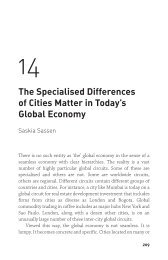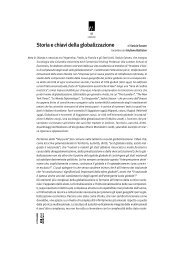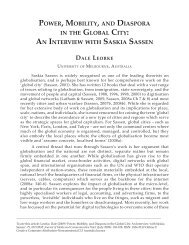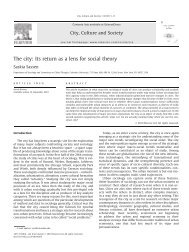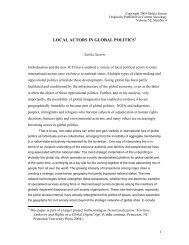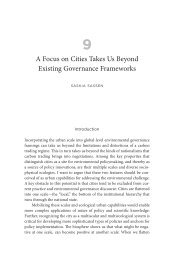Cities in Today's Global Age: An exploration of the ... - Saskia Sassen
Cities in Today's Global Age: An exploration of the ... - Saskia Sassen
Cities in Today's Global Age: An exploration of the ... - Saskia Sassen
You also want an ePaper? Increase the reach of your titles
YUMPU automatically turns print PDFs into web optimized ePapers that Google loves.
THE NETWORK OF GLOBAL CITIES HAS<br />
EXPANDED AS MORE AND MORE FIRMS<br />
GO GLOBAL AND ENTER A GROWING<br />
RANGE OF FOREIGN NATIONAL ECONOMIES<br />
EVEN FACTORIES AND<br />
MINES FEED THE DEMAND<br />
FOR MORE GLOBAL CITIES<br />
At <strong>the</strong> heart <strong>of</strong> this expand<strong>in</strong>g<br />
network <strong>of</strong> (imperfect) global cities<br />
lie two major structural trends.<br />
One <strong>of</strong> <strong>the</strong>se is that even <strong>the</strong><br />
most material economic sectors<br />
(m<strong>in</strong>es, factories, transport systems,<br />
hospitals) today are buy<strong>in</strong>g more<br />
<strong>in</strong>surance, account<strong>in</strong>g, legal, f<strong>in</strong>ancial,<br />
consult<strong>in</strong>g, s<strong>of</strong>tware programm<strong>in</strong>g,<br />
and o<strong>the</strong>r such services for firms.<br />
<strong>An</strong>d <strong>the</strong>se so–called <strong>in</strong>termediate<br />
services tend to be produced <strong>in</strong> cities,<br />
no matter <strong>the</strong> non–urban location<br />
<strong>of</strong> <strong>the</strong> m<strong>in</strong>e or <strong>the</strong> steel plant that is<br />
be<strong>in</strong>g serviced. Thus even an economy<br />
centred <strong>in</strong> manufactur<strong>in</strong>g or m<strong>in</strong><strong>in</strong>g<br />
will feed <strong>the</strong> urban corporate services<br />
economy. Firms operat<strong>in</strong>g <strong>in</strong> more<br />
rout<strong>in</strong>ised and sub–national markets<br />
<strong>in</strong>creas<strong>in</strong>gly buy <strong>the</strong>se service<br />
<strong>in</strong>puts from more local cities, which<br />
expla<strong>in</strong>s why we see <strong>the</strong> growth <strong>of</strong> a<br />
pr<strong>of</strong>essional class and <strong>the</strong> associated<br />
built environments also <strong>in</strong> cities<br />
that are not global. The difference<br />
for global cities is that <strong>the</strong>y are able<br />
to handle <strong>the</strong> more complex needs<br />
<strong>of</strong> firms and exchanges operat<strong>in</strong>g<br />
globally.<br />
A second critical trend is that,<br />
ultimately, be<strong>in</strong>g a global firm<br />
or market means enter<strong>in</strong>g <strong>the</strong><br />
specificities and particularities <strong>of</strong><br />
national economies. This expla<strong>in</strong>s<br />
why such global actors need more<br />
and more global cities as <strong>the</strong>y expand<br />
<strong>the</strong>ir operations across <strong>the</strong> world.<br />
Handl<strong>in</strong>g <strong>the</strong>se national specificities<br />
and particularities is a far more<br />
complex process than simply<br />
impos<strong>in</strong>g global standards.<br />
This process is easier to<br />
understand if we consider<br />
consumer sectors ra<strong>the</strong>r than <strong>the</strong><br />
organisational/managerial ones<br />
addressed <strong>in</strong> this piece. Thus even<br />
such a rout<strong>in</strong>ised operation as<br />
McDonald’s adjusts its products<br />
to <strong>the</strong> national cultures <strong>in</strong> which it<br />
operates, whe<strong>the</strong>r that is France,<br />
Japan or South Africa. When<br />
it comes to <strong>the</strong> managerial and<br />
organisational aspects, matters<br />
become complicated. The global<br />
city conta<strong>in</strong>s <strong>the</strong> needed resources<br />
and talents to bridge between global<br />
actors and national specifics. Even<br />
a highly imperfect global city is<br />
better for a global firm or exchange<br />
than no such city. <strong>An</strong>d this <strong>the</strong>n<br />
expla<strong>in</strong>s why <strong>the</strong> many and very<br />
diverse global cities around <strong>the</strong><br />
world do not just compete with each<br />
o<strong>the</strong>r but also collectively form a<br />
globally networked platform for <strong>the</strong><br />
operations <strong>of</strong> firms and markets.<br />
The network <strong>of</strong> global cities has<br />
expanded as more and more firms<br />
go global and enter a grow<strong>in</strong>g range<br />
<strong>of</strong> foreign national economies. The<br />
management and servic<strong>in</strong>g <strong>of</strong> much<br />
<strong>of</strong> <strong>the</strong> global economic system takes<br />
place <strong>in</strong> this grow<strong>in</strong>g network <strong>of</strong><br />
global cities and city–regions. <strong>An</strong>d<br />
while this role <strong>in</strong>volves only certa<strong>in</strong><br />
components <strong>of</strong> urban economies, it<br />
has contributed to a reposition<strong>in</strong>g <strong>of</strong><br />
cities both nationally and globally.<br />
The rebuild<strong>in</strong>g <strong>of</strong> central areas that<br />
we see <strong>in</strong> all <strong>of</strong> <strong>the</strong>se cities, whe<strong>the</strong>r<br />
downtown and/or at <strong>the</strong> edges, is<br />
part <strong>of</strong> this new economic role. It<br />
amounts to rebuild<strong>in</strong>g key parts <strong>of</strong><br />
<strong>the</strong>se cities as platforms for a rapidly<br />
grow<strong>in</strong>g range <strong>of</strong> globalized activities<br />
and flows, from economic to cultural<br />
and political. This also expla<strong>in</strong>s<br />
why architecture, urban design and<br />
urban plann<strong>in</strong>g have all become more<br />
important and visible <strong>in</strong> <strong>the</strong> last two<br />
decades. It expla<strong>in</strong>s <strong>the</strong> emergence <strong>of</strong><br />
strong competition for space and <strong>the</strong><br />
development <strong>of</strong> a new type <strong>of</strong> politics:<br />
<strong>the</strong> right to <strong>the</strong> city.<br />
42 43




